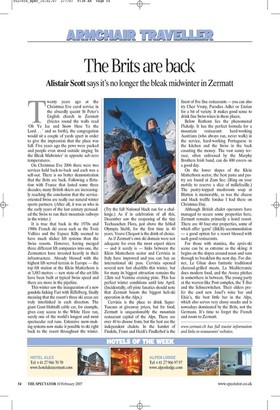The Brits are back
Alistair Scott says it's no longer the bleak midwinter in Zermatt Twenty years ago at the Christmas Eve carol service in the absurdly quaint St Peter's English church in Zermatt (friezes round the walls read 'Oh Ye Ice and Snow bless Ye the Lord. . . ' and so forth), the congregation would sit a couple of yards apart in order to give the impression that the place was full. Five years ago the pews were packed and people even stood outside singing 'In the Bleak Midwinter' in apposite sub-zero temperatures.
On Christmas Eve 2006 there were two services held back-to-back and each was a sell-out. There is no better demonstration that the Brits are back. Following a flirtation with France that lasted some three decades, many British skiers are increasingly reaching the conclusion that the serviceoriented Swiss are really our natural winter sports partners. (After all, it was us who in the early years of the last century persuaded the Swiss to run their mountain railways in the winter.) It is true that back in the 1970s and 1980s French ski areas such as the Trois Vallees and the Espace Killy seemed to have much slicker lift systems than the Swiss resorts. However, having merged three different lift companies into one, the Zermatters have invested heavily in their infrastructure. Already blessed with the highest lift-served terrain in Europe — the top lift station at the Klein Matterhorn is at 3,883 metres — new state-of-the-art lifts have been built at typical Swiss speed and there are more in the pipeline.
This winter saw the inauguration of a new gondola linking Fun i with Riffelberg, finally meaning that the resort's three ski areas are truly interlinked in each direction. The giant Gant-Hohtalli cable car, for example, gives easy access to the White Hare run, surely one of the world's longest and most spectacular red runs. Extensive snow-making systems now make it possible to ski right back to the resort throughout the winter.
(Try the full National black run for a challenge.) As if in celebration of all this, December saw the reopening of the tiny Teehauschen Flora, just above the fabled Olympia Stubli, for the first time in 40 years. Veuve Clicquot is the drink of choice.
As if Zermatt's own ski domain were not adequate for even the most expert skiers — and it surely is — links between the Klein Matterhorn sector and Cervinia in Italy have improved and you can buy an international ski pass. Cervinia opened several new fast chairlifts this winter, but for many its biggest attraction remains the 12km red Ventina cruising piste. This has perfect winter conditions until late April. (Incidentally, off-piste fanatics should note that Zermatt boasts the biggest heli-ski operation in the Alps.) Cervinia is the place to drink SuperTuscans at giveaway prices, but for food, Zermatt is unquestionably the mountain restaurant capital of the Alps. There are over 40 to choose from, but the best are the independent chalets. In the hamlet of Findeln, Franz and Heidi's Findlerhof is the finest of five fine restaurants — you can also try Chez Vrony, Paradies Adler or Enzian for a bit of variety. It makes good sense to drink fine Swiss wines in these places.
Below Rothorn lies the phenomenal Fluhalp. It has the perfect formula for a mountain restaurant: hard-working Austrians (who always run, never walk) in the service, hard-working Portuguese in the kitchen and the Swiss in the back counting the money. The vast sunny terrace, often enlivened by the Murphy Brothers Irish band, can do 400 covers on a good day.
On the lower slopes of the Klein Matterhorn sector, the best pasta and pastry are found at Zum See. (Ring on your mobile to reserve a slice of millefeuille.) The pastry-topped mushroom soup at Blatten is memorable, as was the cheese and black truffle fondue I had there on Christmas Day.
Although British chalet operators have managed to secure some properties here, Zermatt remains primarily a hotel resort. There are 40 four-star properties, some of which offer `garni' (B&B) accommodation — a good option for a resort blessed with such good restaurants.
For those with stamina, the apres-ski scene can be as extreme as the skiing: it begins on the slopes around noon and runs through to breakfast the next day. For dinner, Le Gitan does fantastic traditional charcoal-grilled meats, La Mediterranee does modern food, and the Avena pitches in somewhere in between. The young party at the warren-like Post complex, the T-Bar and the Schneewitchen. Their elders prefer the cool new Josef's wine bar and Elsie's, the best little bar in the Alps, which also serves very classy snacks and is nowadays dominated by the Brits, not the Germans. It's time to forget the French and zoom to Zermatt.
www.zermatt.ch has full tourist information and links to restaurants' websites.













































 Previous page
Previous page